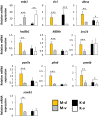Comparative transcriptomics reveals candidate carotenoid color genes in an East African cichlid fish
- PMID: 31948394
- PMCID: PMC6966818
- DOI: 10.1186/s12864-020-6473-8
Comparative transcriptomics reveals candidate carotenoid color genes in an East African cichlid fish
Abstract
Background: Carotenoids contribute significantly to animal body coloration, including the spectacular color pattern diversity among fishes. Fish, as other animals, derive carotenoids from their diet. Following uptake, transport and metabolic conversion, carotenoids allocated to body coloration are deposited in the chromatophore cells of the integument. The genes involved in these processes are largely unknown. Using RNA-Sequencing, we tested for differential gene expression between carotenoid-colored and white skin regions of a cichlid fish, Tropheus duboisi "Maswa", to identify genes associated with carotenoid-based integumentary coloration. To control for positional gene expression differences that were independent of the presence/absence of carotenoid coloration, we conducted the same analyses in a closely related population, in which both body regions are white.
Results: A larger number of genes (n = 50) showed higher expression in the yellow compared to the white skin tissue than vice versa (n = 9). Of particular interest was the elevated expression level of bco2a in the white skin samples, as the enzyme encoded by this gene catalyzes the cleavage of carotenoids into colorless derivatives. The set of genes with higher expression levels in the yellow region included genes involved in xanthophore formation (e.g., pax7 and sox10), intracellular pigment mobilization (e.g., tubb, vim, kif5b), as well as uptake (e.g., scarb1) and storage (e.g., plin6) of carotenoids, and metabolic conversion of lipids and retinoids (e.g., dgat2, pnpla2, akr1b1, dhrs). Triglyceride concentrations were similar in the yellow and white skin regions. Extracts of integumentary carotenoids contained zeaxanthin, lutein and beta-cryptoxanthin as well as unidentified carotenoid structures.
Conclusion: Our results suggest a role of carotenoid cleavage by Bco2 in fish integumentary coloration, analogous to previous findings in birds. The elevated expression of genes in carotenoid-rich skin regions with functions in retinol and lipid metabolism supports hypotheses concerning analogies and shared mechanisms between these metabolic pathways. Overlaps in the sets of differentially expressed genes (including dgat2, bscl2, faxdc2 and retsatl) between the present study and previous, comparable studies in other fish species provide useful hints to potential carotenoid color candidate genes.
Keywords: BCO2; Body coloration; Carotenoids; Cichlidae; Color genes; Gene expression; Lipids; RNA-Seq; Tropheus.
Conflict of interest statement
The authors have no competing interests to declare.
Figures




References
-
- Svensson P, Wong B. Carotenoid-based signals in behavioural ecology: a review. Behaviour. 2011;148(2):131–189. doi: 10.1163/000579510X548673. - DOI
-
- Blount JD, McGraw KJ. Signal functions of carotenoid colouration. Carotenoids Birkhäuser Basel: Springer; 2008. pp. 213–236.
Publication types
MeSH terms
Substances
Grants and funding
LinkOut - more resources
Full Text Sources
Other Literature Sources
Research Materials
Miscellaneous

